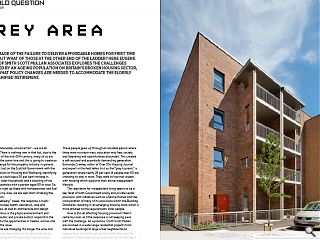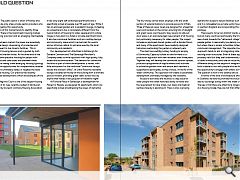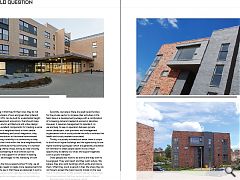Retirement accommodation: Grey Area
19 Oct 2015
Much is made of the failure to deliver affordable homes for first time buyers but what of those at the other end of the ladder? Here Eugene Mullan of Smith Scott Mullan Associates explores the challenges presented by an ageing population on Britain’s broken housing sector, asking what policy changes are needed to accommodate the elderly for a dignified retirement.
There is one undeniable, universal fact – we are all getting older! There is nothing new in that but, due to the demographics of the mid-20th century, many of us are getting old at the same time and this is going to create an almighty challenge for the property industry in general. This fact is not lost on the Scottish Government with the recent Commission on Housing and Wellbeing identifying that by 2037 we could see a 50 per cent increase in the number of older households and a doubling of the number of households with a person aged 80 or over. So, as an issue, it is right up there with homelessness and fuel poverty, but in my view, we are well short of taking the necessary action.Like all “wellbeing” issues, the response is multi-sectoral and involves health, education, care and economic issues, as well as architecture and design. However, our focus is the physical environment and how both the public and private sectors respond to the necessity and to the opportunities it creates, will be vital to addressing the issue.
Older people are changing. No longer the wise, but essentially passive, figurehead of the extended family, we are now dealing with the post-war baby boomers. These people grew up through an enviable period where there were no major wars, education was free, society was liberating and opportunities abounded. This created a self-assured and essentially demanding generation. Esmonde Crawley, editor of Over 50s Housing Journal and expert in the field refers to it as the “grey tsunami,” a generation where nearly 28 per cent of people over 60 are choosing to stay in work. They want to live their dream, with housing which supports their active independent lifestyle.
This aspiration for independent living seems to be a key facet of both Government policy and private sector provision, with initiatives such as Lifetime Homes and the incorporation of many of its provisions within the Building Standards, resulting in an emerging housing stock which is more attuned to the requirements older people.
How is this all affecting housing provision? Well it certainly looks as if the response is not keeping pace with the challenge. As a practice, Smith Scott Mullan are involved in a wide range residential projects from individual buildings to large scale neighbourhood regeneration and although we have definitely seen the elevation of this issue, we are surprised at how low key it appears to be. The public sector is short of finance and there seems to be only a few private sector providers who are actively targeting this opportunity.
Any analysis of this market tends to identify three major sectors. There is the mainstream housing market, specialist housing provision and an emerging intermediate provision.
In the mainstream market, the issues are essentially one of inclusive design, downsizing of properties and a tendency to want to live close to facilities. This is applicable to all housing tenures and is guided by both public policy and market forces. At the other end of the spectrum we have specialist housing for people with particular needs and care issues and between these extremes we are seeing a new emerging housing typology which retains the opportunities for independence, enables care support and ultimately delays or negates the need to move to care housing. Our practice has recently completed three developments which are examples of this trend.
Elizabeth Maginnis Court is one of the largest housing developments of its type recently created in Edinburgh. Commissioned by Dunedin Canmore Housing Association it has sixty-eight self-contained apartments and is specifically aimed at people over 55 years of age. While it has an enclosed garden and a residents’ lounge, its feeling as somewhere to live is completely different from the typical notion of housing for older people and its whole image is more akin to a hotel or private apartment block. It also has communal facilities such as a rooftop lounge and community space which can be hired for events and an informal café at its entrance used by the local community and residents.
Our development at Little Road in Edinburgh for Dunedin Canmore and The Edinburgh Merchant’s Company takes a similar approach with high quality, fully accessible accommodation. The demand for communal facilities as part of these developments is varied, with little enthusiasm for the traditional “communal lounge beside the warden’s office”. At Little Road the residents lounge is located at the top of the building with a dramatic picture window, providing great views across the city skyline that makes it very popular on fireworks night!
At Fortune Place in Edinburgh, a development for Places for People, we designed 54 apartments which are specifically aimed at addressing the issues of dementia. The four storey corner block employs a lift and small section of external balcony to provide access to 12 flats. Three of these at upper levels are designed for wheelchair users and located on the corner, ensuring lots of daylight and great views over the park. Easy access to safe out door space is an acknowledged requirement of all housing but particularly necessary for older people. The project includes an enclosed shared garden with a Garden Room and many of the apartments have carefully designed balconies overlooking the garden or adjacent park.
The client secured Big Lottery funding to employ a Community Capacity builder to take forward a co-production approach with new residents over three years. Together they will develop the communal outdoor spaces, produce a programme of regular events and activities to utilise the garden room and ensure each resident is supported to participate, as they choose, in the life of the wider community. This approach will create a sustainable development ultimately managed by the residents.
Access to activities and facilities is a key issue for older people who often have less ability to travel and the requirement to have shops, bus stops and medical centres close by is paramount. There is also a growing demand for access to leisure facilities such as health clubs and it is noticeable how private sector housing providers in southern England are incorporating this into their package.
There seems to be two distinct trends emerging. If we look at many countries (particularly the United States) we see a trend towards the “retirement village” where older people gather in reasonably low density surroundings but where there is access to facilities (often golf!) and communal management. The opposite (more European approach) tends to aim at integrating older people into existing urban structures. Both of these approaches are probably valid but they are fundamentally different. One is based in exclusivity and one on inclusivity, with the difference being on the degree of integration. People have both a desire to mix with people who are like them and the opportunity to engage with others as they choose. The question is how is this balance struck.
In terms of the kind of architecture which we design in Scotland, we tend to promote the inclusive model and see our buildings acting within the wider urban structure. The key is that these are often fairly large buildings and as a housing model, they are not that different from student housing in that they fill their sites, they do not require large numbers of cars and given their inherent requirement for lifts, can be built to a substantial height. In terms of development economics, that should make them attractive and in architectural and urban design terms, they are excellent components for creating a sense of urbanity within a neighbourhood or town centre.
In terms of wellbeing and social integration, they are excellent contributors to the overall environment. Older people bring a stability to a community as they spend much of their time within the local neighbourhood.They can also contribute to the community in a number of ways, staffing charity shops, acting as road crossing wardens and volunteering at local schools such as providing one to one support for children in reading. Providing huge advantages for the wellbeing of both parties.
So what are the future opportunities? Firstly, we all know that society needs to create more developments for older people. The key is that these are designed in such a way that they support wider agendas and contribute to the type of urbanism envisaged under current planning policies.
Secondly, we believe there are great opportunities for the private sector to increase their activities in this field. Here is a development package with a combination of increasing demand created at economic densities. However, it requires management to operate it, so we are likely to see co-operation between private sector developers, care providers and management organisations which could provide the skills to address the health and social problems associated.
Thirdly, in a purely architectural sense, there is scope to build much higher buildings and the opportunity to use higher building typologies (which are generally unsuitable for families) for older people seems to be a major opportunity to densify our cities and support agendas such as public transport.
Older people also want to be active and they want to be engaged. They want sport and they want culture. We believe they also want buildings which excite and inspire them. Often they are at a period in their life where they do not have to accept the mass housing model on the view that it “is only a step on the property ladder” but can look for accommodation that they seriously want to live in.
Exciting times in the residential world!
Photography by McAteer
|
|
Read next: HES: Power of Two
Read previous: Scotland Build 2015
Back to October 2015
Browse Features Archive
Search
News
For more news from the industry visit our News section.
Features & Reports
For more information from the industry visit our Features & Reports section.





